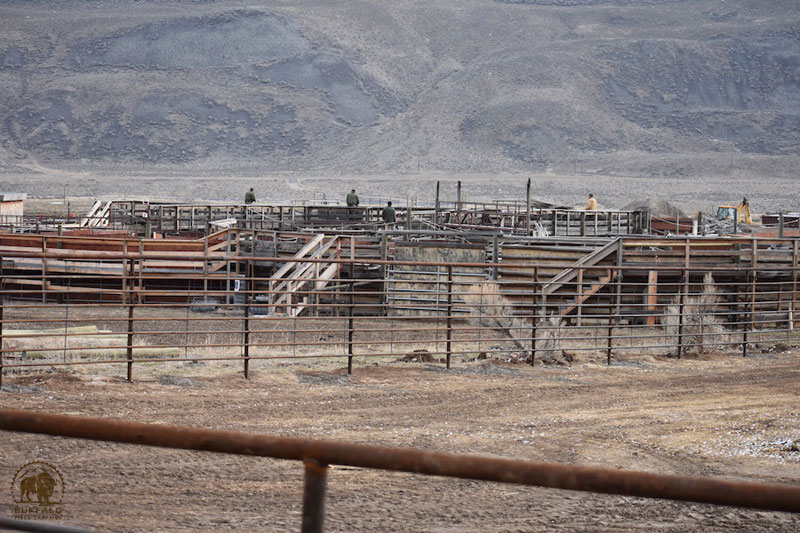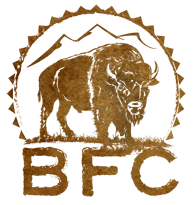A female buffalo separated from her family group who will all be killed, is held in a sorting pen at Yellowstone’s Stephens Creek buffalo trap, where she waits before being loaded onto a stock trailer that will take her to the slaughter house. BFC photo by Stephany Seay
Yellowstone National Park has just released their 2017 “Status Report on the Yellowstone Bison Population,” and it reveals what we feared: the Central Herd, who migrates west into the Hebgen Basin, and also north, into the Gardiner Basin has declined by nearly half. BFC patrols in the past few springs had noticed that we were seeing about half the number of buffalo coming to their calving grounds on and around Horse Butte. We looked for them inside the Park, but found very few. We contacted Yellowstone’s bison biologist, Rick Wallen, who suggested we look in the places we already had. Where had they gone? Well, the harsh reality is that, the Interagency Bison Management Plan (IBMP) is causing a fundamental and tragic shift in the buffalo’s behavior and migration patterns. Of course, Yellowstone will never admit this, heck they don’t even want to acknowledge that the Central and Northern herd have different genetic structures, much less what they are doing to the buffalos’ genetics as they arbitrarily slaughter them.
Agency science is nothing but a tool for politics. Whom does Yellowstone serve?
Managers know that buffalo from the Central Herd migrate west into the Hebgen Basin and also north into the Gardiner Basin, and are doubly exposed and impacted by capture for slaughter operations and hunting. After the winter slaughters of 2005–2006 and 2007–2008 the Central Herd was decimated, their numbers stagnated, and declined by nearly half in the last year. The Central herd is in dire straights. Yellowstone biologists don't have anything to differentiate Central from Northern buffalo except for a handful of radio collared females — they have no clue where the other family members who are captured and killed in the Gardiner basin come from. They do not know, nor do they seem to care what the significantly damaging cumulative impacts of their management schemes are doing to our country’s last wild, migratory buffalo populations.
During 2011 more than 600 buffalo were captured and held for nearly five months. Buffalo from both the Northern and Central herds were captured and lived in confinement for so long that buffalo from different family groups — and even different herds — formed strong bonds. It is likely that when they were released, these buffalo stayed together, some leaving their home ranges and families to stay with the new friends. BFC photo by Stephany Seay.
They may be loath to admit it, or not willing to consider it, but Yellowstone National Park's capture program at Stephens Creek may have altered the population structure, behavior, and social bonds of around 600 buffalo held in captivity and released during the spring of 2011. Social bonds are a uniting force in a herd animal like the buffalo, and extended family ties spanning several generations of buffalo can be seen among matriarch led groups. It is altogether possible that when this cohort of buffalo were finally released after months in captivity, the bonds formed between the Central and Northern herds were so strong that they stayed together on the Northern range. Based on Yellowstone’s report of radio-collared females, there is some evidence indicating Central herd buffalo are now spending their summer in the Northern range, a dramatic shift away from the Central herd's rutting territory.
The entire Yellowstone population declined by 12%, reduced - through slaughter, hunting, and quarantine — to just 4,800 animals. BFC photo by Stephany Seay.
The outcome for buffalo is tragic. Managers tell us and want us to believe everything is fine. But the fact is Yellowstone National Park's and the state of Montana's unnecessary and intensive management scheme has altered the buffalo’s population structure for the worse. As a consequence, we are witnessing the Central herd rapidly disappear. With more buffalo on the Northern Range, more will be killed when they migrate into the Gardiner Basin killing zone.
With the very structure of the buffalo’s population being artificially manipulated and altered, threats outside of management – extended drought, winter range freezing under ice – make the whole population much more vulnerable to extinction. It is utter negligence on the part of Yellowstone National Park and the state of Montana, who are crushing the future of the sacred buffalo, our country’s national mammal.
A view of Yellowstone’s Stephens Creek buffalo trap where more than 700 buffalo were captured and shipped to slaughter last season. Yellowstone and their IBMP cohorts, caving to pressure from Montana’s livestock industry, intend to kill between 600-1,200 buffalo this coming year. Whom does Yellowstone serve? BFC photo by Stephany Seay.
So what do the Park biologists have to say to managers in the face of evident human mismanagement? Among other things, they recommended that “[s]ome captured bison may need to be held at the Stephens Creek facility through winter and released in spring to meet these removal composition objectives." Ho-hum off we go to manage another man made disaster...
Their recommendations:
- About 600 bison would need to be removed from the population during winter 2017-2018 to stabilize population growth... We do not recommend removing more than 1,250 bison, which would be greater than 25% of the current population.
- When possible, bison should be removed in proportion to their occurrence in the population (73% adults, 12% yearlings, and 15% calves; 46% females and 56% males). Some captured bison may need to be held at the Stephens Creek facility through winter and released in spring to meet these removal composition objectives.
- Population management actions during winter 2017-2018 should focus on bison breeding in northern Yellowstone (i.e., the northern herd) by using telemetry data to inform the timing and magnitude of removals.
- We recommend using harvests in Montana and culling at Stephens Creek to meet population management objectives...
- We do not recommend management removals or state and tribal harvests of bison in the western management area in Montana. Bison migrating west of the park during winter are almost entirely from the central breeding herd, which has decreased substantially in abundance during recent years.
TAKE ACTION! The only solution here is an immediate moratorium on Yellowstone’s capture-for-slaughter scheme. We must not allow them to move forward with their killing plans. Year after year we try to stop this, so we are going to have to try even harder now. We need you to stand with us on the front lines. And we need you to let Yellowstone’s Superintendent Dan Wenk and Montana Governor Steve Bullock know that we will not stand by and allow this to happen: This email address is being protected from spambots. You need JavaScript enabled to view it. / 307-344-2002 - This email address is being protected from spambots. You need JavaScript enabled to view it. / 406-444-3111.











